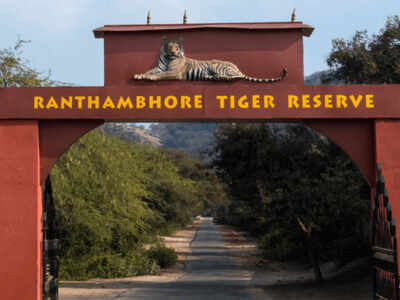- News
- City News
- jaipur News
- Problem of plenty after tiger count in Rajasthan crosses 100 mark
Problem of plenty after tiger count in Rajasthan crosses 100 mark

Ranthambore National Park (RNP)
JAIPUR: Rajasthan is now home to more than 100 tigers in the wild. The count breached the century mark after tigress T-111 gave birth to a set of quadruplets in Ranthambore National Park (RNP). The exact figure stands at 102.
The state houses two major tigers reserves, Ranthambore and Sariska, having 69 and 23 big cats, respectively. The Mukundra Hills Tiger Reserve (MHTR), which was declared as a tiger reserve in 2013, houses only one tigress after the state forest department efforts to re-populate the reserve went futile.
In the past three years, the births of 33 tiger cubs have been recorded and Rajasthan now has the ninth highest population of big cats among all states. State forest minister Sukhram Bishnoi said, “We are carrying out a study to develop a new habitat for tigers. A proposal to upgrade Ramgargh Vishdhari Sanctury to a tiger reserve has also been sent to the National Tiger Conservation Authority (NTCA).”
In its budget last year, the government had announced to develop the sanctuary as a tiger reserve to provide additional habitat to Ranthambore tigers, improve ecosystem and strengthen tourism. The Ramgarh Vishdhari sanctuary is spread across 1,071 sq km, of which 302sqkm will be made into a critical tiger habitat and the rest into a buffer zone.Though the news of crossing the 100 mark is a great achievement for wildlife enuthusisats, it has brought worries to the park managers as area in RNP is bursting at its seams.
As tigers in the reserve are squeezed for territory due to high density, the chief conservator of forest (CCF) had put forward a proposal to relocate six of them. But many believe the proposal will never see the light of the day as Rajasthan does not have a safe habitat to relocate these tigers.
An wildlife expert said, “There is enough scope to improve the wildlife habitat in adjoining areas of Ranthambore. Also, more tigers can be accommodated in Sariska Tiger Reserve after putting up proper target in place. The forest department should meanwhile work to develop new tiger reserves in the state.”
The state houses two major tigers reserves, Ranthambore and Sariska, having 69 and 23 big cats, respectively. The Mukundra Hills Tiger Reserve (MHTR), which was declared as a tiger reserve in 2013, houses only one tigress after the state forest department efforts to re-populate the reserve went futile.
In the past three years, the births of 33 tiger cubs have been recorded and Rajasthan now has the ninth highest population of big cats among all states. State forest minister Sukhram Bishnoi said, “We are carrying out a study to develop a new habitat for tigers. A proposal to upgrade Ramgargh Vishdhari Sanctury to a tiger reserve has also been sent to the National Tiger Conservation Authority (NTCA).”
In its budget last year, the government had announced to develop the sanctuary as a tiger reserve to provide additional habitat to Ranthambore tigers, improve ecosystem and strengthen tourism. The Ramgarh Vishdhari sanctuary is spread across 1,071 sq km, of which 302sqkm will be made into a critical tiger habitat and the rest into a buffer zone.Though the news of crossing the 100 mark is a great achievement for wildlife enuthusisats, it has brought worries to the park managers as area in RNP is bursting at its seams.
As tigers in the reserve are squeezed for territory due to high density, the chief conservator of forest (CCF) had put forward a proposal to relocate six of them. But many believe the proposal will never see the light of the day as Rajasthan does not have a safe habitat to relocate these tigers.
An wildlife expert said, “There is enough scope to improve the wildlife habitat in adjoining areas of Ranthambore. Also, more tigers can be accommodated in Sariska Tiger Reserve after putting up proper target in place. The forest department should meanwhile work to develop new tiger reserves in the state.”
FacebookTwitterLinkedinEMail
Start a Conversation
end of article
Quick Links
Delhi Air PollutionDelhi TemperatureChennai WeatherBangalore TemperatureCovid vaccination centres in DelhiCoronavirus in DelhiRTPCR test in GurgaonHyderabad RainPollution level in BangaloreDelhi SmogDelhi TemperatureNoida AQIGurgaon AQI todayFire in MumbaiMumbai RainsCovid 19 RT PCR Test in NoidaDelhi AQI todaySrinagar encounter
